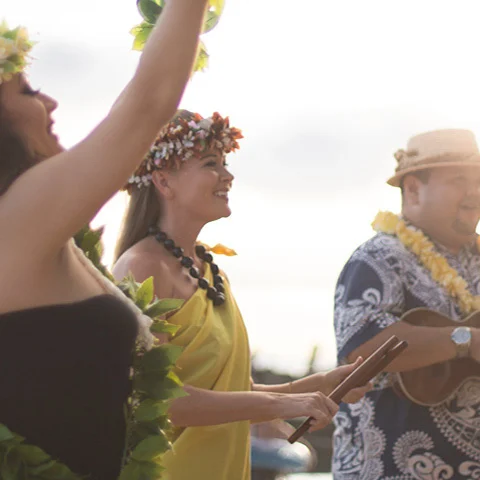
Hula: Body & Spirit
More than swaying hips, elegant hand gestures and lithe feet, hula embodies the history of the Hawaiian islands. Centuries ago when gods and people shared these Islands, and time was measured by the waxing and waning of the moon, the hula was born. The first dances were linked to Pele, goddess of volcanic fires, who made a request to her younger sister, Hi‘iaka. The Pele cycle provided the hula with a repertoire that was both religious and entertaining. Rhythmic and poetic oli (chants) combined with disciplined motion tell stories of love and passion, anger and revenge, as well as loyalty and betrayal, all parts of Pele’s tempestuous nature.
While the hula is distinctively Hawaiian, it was once intertwined with the rhythmic dances brought to Hawai‘i by settlers from the Tahitian islands a thousand or more years ago. However, when contact between Tahiti and Hawai‘i was lost, the Hawaiian culture evolved in isolation. Hula was part of that evolution, with dancers inspired by lyrical chants and paced by deep-throated, shark-skin-covered drums (pahu), gourd rattles (‘uli‘uli), slit-bamboo sticks (pu‘ili), tapping sticks (kala‘au), clapping stones (‘ili‘ili) and dogtooth anklets (kupe‘e niho‘ilio).
Presently, two styles of hula are danced, each with its own variations. Hula kahiko follows a traditional path in terms of costume and theme, while hula ‘auana moves toward the present. Hula ‘auana is enchanting, most often danced by gracious wahine (women) of all ages in long mu‘umu‘u, and you’ll enjoy watching it throughout your Hawaiian vacation. But it’s in kahiko that the real story lies … literally.
In ancient Hawai‘i, everything was always taught through chanting and storytelling, detailing and cataloging the lineage of a people and all of the events in their personal—and collective—history. Physical motions assigned to interpret and represent the chants are lessons and prayers, worshipping and honoring not only the chants themselves but those who chanted them before.
Alongside Hawaiian music and chant, the movements are intended to emphasize a certain message, with the swaying movements representing everything from a tree moving in a breeze to a feeling of yearning. Dancers are trained in movements that can be reconfigured in a wide number of storytelling formats. Hands use sign language for ideas like love or anger, or objects like the moon, rain or a fragrant flower. While standards and rituals attached to the dance do exist, hula differs from island-to-island, each halau hula (hula school) influenced by the style of its kumu (teacher). This beautiful expression can either be performed in a sitting position (noho dance) or standing position (luna dance), and you're likely to see a combination of both when watching a Hawaiian performance.
Prior to 1820, both men and women danced hula, sometimes together and sometimes apart. However, shortly after the missionaries arrived, neither genders performed it because of their disapproving presence. Missing the spiritual message and mistaking the sensual for sin, the missionaries sought to repress it, nearly eliminating its practice in the process. Luckily, in more remote places where the ways of old lingered, the hula was saved and taught. The few who knew the chants and dances safeguarded what was on the cusp of being lost and paved the way to hula’s restoration as a cultural tradition.
King Kalākaua is largely credited with having rescued the hula from oblivion, showcasing performances at his coronation (1883) and birthday jubilee (1886), as well as sponsoring its practice and expanding the repertoire with new chants and dances.
Today, hundreds of halau and thousands of dancers, including many far from Hawaiian shores, dance hula, learning not only the movements but also its spiritual and aesthetic message. A cultural tradition on the verge of being lost is no longer endangered. Kumu and dancers perform to the highest of standards, adapting stylistically in ways that keep the hula a living art and a cultural treasure that defines what is appealingly unique about Hawai‘i.
As part of Outrigger Resorts' Signature Experiences, you too can learn the art of authentic hula yourself through complimentary lessons at Outrigger Waikiki Beach Resort and Outrigger Reef Waikiki Beach Resort. Here you can also try other Hawaiian cultural activities with Outrigger's cultural director, Aunty Luana Maitland - such as making a kukui nut bracelet or taking an ukelele lesson that let you explore the island's unique culture. Or swing by Waikiki Beach Walk for a free Hula class on the plaza every Sunday morning. The unique and enriching experiences enable guests from around the world to bring a little bit of Hawaii's spirit home with them.